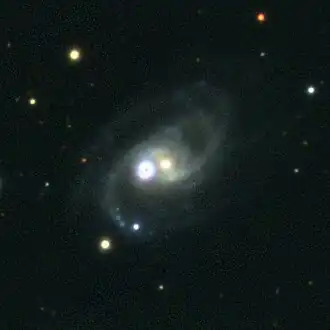Arp 7
| Arp 7 | |
|---|---|
 Arp 7 by PanSTARRS | |
| Observation data (J2000 epoch) | |
| Constellation | Hydra[1] |
| Right ascension | 8h 50m 30.0s[2] |
| Declination | −16° 37′ 00″[2] |
| Redshift | 0.018620±0.000002[3] |
| Heliocentric radial velocity | 5,582±1 km/s[3] |
| Galactocentric velocity | 5,384±8 km/s[4][3] |
| Distance | 103.9 ± 146.4 Mly (31.853 ± 44.901 Mpc)[3] |
| Apparent magnitude (V) | 14.5[3] |
| Characteristics | |
| Type | SB(rs)bc: HII[3] |
| Size | 40,737 ly (12.49 kpc) (diameter; 25.0 B-mag arcsec−2)[3][a] 28,767 ly × 26,451 ly (8.82 kpc × 8.11 kpc) (diameter; "total" magnitude)[3][a] |
| Apparent size (V) | 1.3′ × 1.0′ [3] |
| Other designations | |
| PGC 024836,[3] APG 7[2] | |
Arp 7 (PGC 24836) is a spiral galaxy in the constellation Hydra.[1] Redshift-independent measurements of its distance vary widely, from 5.9 to 83.7 megaparsecs (19.24 to 273.0 million light-years).[3] Its morphological classification is SB(rs)bc,[3] meaning it is a barred spiral galaxy with some ring-like structure.
Arp 7 was imaged by Halton Arp and included in his Atlas of Peculiar Galaxies under the category of 'split arm' galaxies.[5] Five other galaxies are also included in this section of the atlas: Arp 8 (NGC 497), Arp 9 (NGC 2523), Arp 10 (UGC 1775), Arp 11 (UGC 717), and Arp 12 (NGC 2608).
References
- ^ a b Seligman, Courtney. "Celestial Atlas: PCG Objects 24500–4999". Retrieved 2015-11-25.
- ^ a b c Results for ARP 007. SIMBAD Astronomical Database. Retrieved 2015-11-25.
- ^ a b c d e f g h i j k l "Detailed Information for Object Arp 7". NASA/IPAC Extragalactic Database. Retrieved August 3, 2025.
- ^ . Bibcode:1991RC3.9.C...0000d.
{{cite journal}}: Cite journal requires|journal=(help); Missing or empty|title=(help) - ^ Arp, Halton (1966). "Atlas of Peculiar Galaxies". Figure 1. Retrieved 2015-11-25.
Notes
- ^ a b The quick-look major axis physical diameters given by NED of 12.49 kiloparsecs (40,700 light-years) and 8.82 by 8.11 kiloparsecs (28,800 by 26,500 light-years) were based on distance estimates of 31.853 ± 44.901 Mpc (103.9×106 ± 146.4×106 ly) using a scale of 154.4 parsec/arcsec multiplied with given angular diameters.